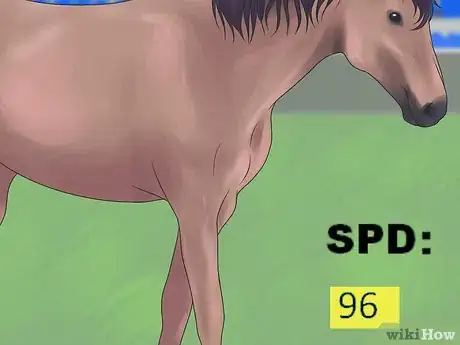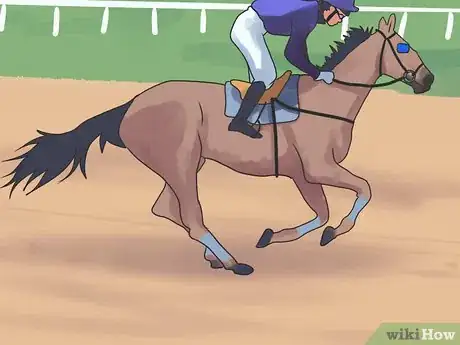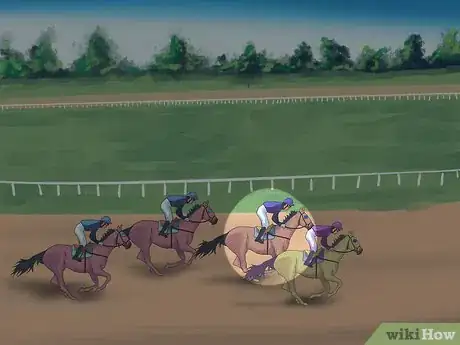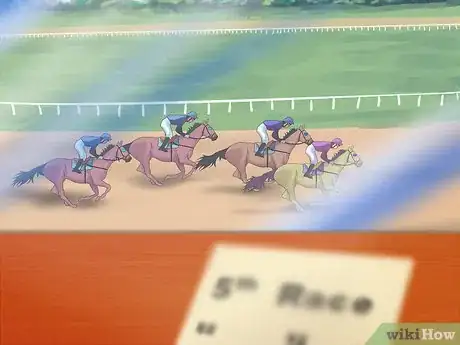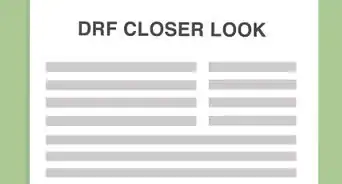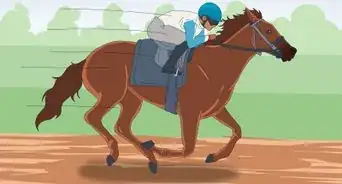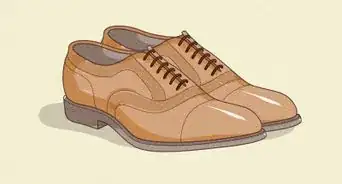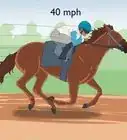wikiHow is a “wiki,” similar to Wikipedia, which means that many of our articles are co-written by multiple authors. To create this article, 29 people, some anonymous, worked to edit and improve it over time.
wikiHow marks an article as reader-approved once it receives enough positive feedback. In this case, 82% of readers who voted found the article helpful, earning it our reader-approved status.
This article has been viewed 307,451 times.
Learn more...
Horse racing is one of the only sports that allow fans to participate in the game directly, through wagering. Millions of dollars are bet each day on races in North America, enticing players to put their handicapping skills to the test. It truly is an art form, and getting great at it will take time – but it may pay off.
Steps
Decoding the Racing Form
-
1Hone your handicapping skills. Handicapping is the process of determining which horse has the best chance to win a race. It is a test of your creative intelligence, not systematic computation. To do this, you’ll need the Daily Racing Form, which you can buy upon entering the track.
- The DRF is full of a whole bunch of stats and figures, which we’ll be discussing below. Once you know how to decode the racing form, you’ll have a pretty good idea of which horses will (or at least should) do well.
-
2Look at the Beyer Speed Figures. Beyer numbers often serve as a starting point in the handicapping process. They are the bold numbers found in the middle of each DRF, indicating the horse's past performances. Handicappers often use the horse with the highest last-race Beyer as their focus and eliminate horses that have never run a figure close to this horse's figure. There are two numbers: pace and speed.
- Pace projections. By scanning the past performances, handicappers try to estimate the pace of the current race and determine which horse will benefit most from it. The first bold-face number, pace, shows whether the horse likes to be on the early lead or not.
- Speed projections. This is not the same as pace. Speed (the 2nd bold-faced number) shows the horse’s ability to pass other less-speedy horses as they near the finish line. Speed does not equal consistency (which pace can).
Advertisement -
3Look at that race’s distance. Distance is one of the biggest factors when it comes to betting. If you’re looking at a horse that tires out around six furlongs and you’re at the Belmont Stakes where it’s a whopping twelve furlongs, you probably don’t want to bet that horse. How has your horse run in other races of this similar length?
- Distance, pace, and speed are very powerful in tandem. Looking at how your horse runs (and, as importantly, how she finishes) in different distances will clue you in to how she’ll perform in races of different lengths.
-
4Take into account the track and the weather. This is called “track bias”: no single factor in handicapping can change the complexion of a race like a track bias. If wise bettors detect any kind of bias in the racing surface, they incorporate it into their decision-making. What is track bias? Every horse has their preferred surface, whether it’s turf or dirt. You want to know how your horse will perform on whatever your track is.
- Don’t forget the weather! A little rain quickly turns that dirt into mud. Take into account how your horse has performed in this type of weather, not just the type of track.
-
5Consider “form cycles.” Handicappers must ask themselves questions about each horse. Is her last race a true representation of her ability? Is she likely to improve or regress on race day? Which horses raced against a bias last out and can be expected to offer a peak performance today? Horses, just like humans, are never 100% consistent.
- One thing to consider is the size of the purse and where the horse is coming from. If the size of the purse is large, this is one classy horse – she’ll probably be pretty consistent (she didn’t get to the big leagues for nothing). And if she got flown in from somewhere, her owners paid a pretty penny to get her there, so they’ll probably break out all the stops to see her win.
-
6Look at the horse’s post position. In the list of the horse’s previous races, you’ll see her previous post position. Sprint races around one turn usually favor outside posts, while route races (races with 2 turns) at longer distances often favor inside post positions. What’s this race? And what is your horse’s post position? Has she run a race like this in the past and done well?
- You may want to consider other horse's post positions, too. If a certain horse seems to be speedier on the inside and for this race is on the inside, this horse will be serious competition.
Placing Your Bets
-
1Get familiar with your track, the tracks being simulcast, and get your papers. With your umbrella and binoculars in hand, get going to your track. Step out onto the track before the races begin – what’s it like? Find the bettor’s window, and sit down to read your DRF. There are a few other pieces you can get for purchase, too:[1]
- ’’A racetrack program.’’ This has information on all the horses, jockeys, trainers, and owners. The cost is usually $3.
- ’’Public handicapper selections.’’: If your racetrack or OTB (off-track betting) is covered by the local newspaper, they may pay a handicapper to make daily horse selections. The cost is usually 50 cents.
- ’’Handicapping tip sheets.’’ These are daily selections published by handicappers at the racetrack. The cost is usually $2.
- Tracks often simulcast from other tracks, too. This means you can watch the races live in one track and watch ‘’and bet on’’ races at other tracks being simulcast on TV. Imagine the bank you’d make if you won both!
-
2Buy a Daily Racing Form. This form is the most important weapon in a handicapper's arsenal. It provides detailed information on each horse running in the day's races. It costs $4 at most race tracks and is outlined in the above section. At first glance, it’s quite intimidating – but once you learn what all the numbers mean, it’ll be your best friend.[2]
- Give yourself some extra time to sit down and study it. As you get better and better you'll need less and less time, but for now work at least a few races in advance. Being patient and doing your homework will increase your odds like little else.
-
3Familiarize yourself with different types of bets. When you go up to window, you need to know what you want! Here are your basic options:
- Show – your horse can get 1st, 2nd, or 3rd and you win
- Place – your horse can get 1st or 2nd and you win
- Win – your horse must get 1st to win
- Quinella – bet 2 or 3 horses to finish 1st or 2nd, in any order
- Exacta – bet 2 horses that must finish in 1st and 2nd in exact order
- Trifecta – bet 3 horses that must finish in 1st, 2nd, and 3rd in exact order
- Superfecta – bet 4 horses that mush finish in 1st, 2nd, 3rd, and 4th in exact order
-
4Know your odds and payouts. Let's say you bet $2 on a horse to win (which is the standard minimum bet). To determine how much you would win if she wins, take the odds of your horse and multiply the first number by 2 (your bet), then divide that by the second number, and then add $2 (again, your bet).[3]
- Let's say your horse has 3/1 odds. You multiple 3x2 to get $6. Divide that by 1, which is still $6. Then you add $2. You would make $8 on a $2 wager.
- Let's take a bet where lots of people are betting, like on a horse with 1/9 odds. You multiply 1x2 to get $2. Then 2/9, which is about 20 cents. Plus $2, and your winnings is $2.20.
-
5Consider each horse’s individual characteristics. After you’ve gotten down all the big numbers, you also want to look at other tidbits of information in the DRF. There’s some information on there about each horse that can give them the edge to win. Consider:
- If a horse was recently claimed, or bought. If someone is willing to shovel out a chunk of change for a horse, they probably have potential.
- If there are any recent equipment changes. The owner is zeroing in on how to improve their horse's chances.
- Look at her workout speeds. Are they consistent? If she's running at the same speed every day, she's probably in top form.
- Consider the gender and breed. Generally speaking, males are faster than females. Only three fillies (females) have ever won the Kentucky Derby, for example.[4] And better-bred horses will outperform others, too.
-
6Consider working out of two pockets. Any good bettor sometimes bets big and sometimes bets small. To keep yourself going and to keep from being bored between races you're very excited about, have a smaller pocket to work out of. You'll be $2 here, $2 there, and then when that big race comes up, you'll turn to your other pocket, and bet $20.
- Betting, quite frankly, in any arena, can be dangerous. It's always important to know when to stop. Having 2 separate pockets can help you keep your head above water, too.
-
7Place your bets at the window (and later collect your winnings). Remember this order: racetrack, race, dollar amount, bet type, horse number.[5] So when you walk up to the window to talk to an actual human, this is the formula you follow. Here's an example:
- "At Saratoga, I'd like to bet on the 5th race – a $4 exacta on horses 3 and 7." Make sure to do this before the 5th race, of course. Check your ticket before you leave the window, just to make sure it's correct.
- The racetrack is specified as many tracks are likely simulcast at the track you are currently in.
- "At Saratoga, I'd like to bet on the 5th race – a $4 exacta on horses 3 and 7." Make sure to do this before the 5th race, of course. Check your ticket before you leave the window, just to make sure it's correct.
Improving Your Game
-
1Track your own records. Just like you would if you were playing poker, keep track of your own performance. Where do you seem to be making assumptions that aren't correct? What tidbits are you missing, resulting in betting on the wrong horse? What are you strong points? Knowing how you bet can help you overcome any personal weaknesses, too.
- When you go to the track, bring a pen and paper with you or a type of scorecard, just like avid fans of other sports do. Keep track of the results in addition to how you bet to jog your memory later.
- Establish what types of bets produce the highest returns for you and make them the focus of your wagering.
- Determine what types of races you have the most success with and which you can't decipher. If you conclude that you seldom pick winners on turf, avoid betting on grass races until you improve your handicapping.
-
2Read books on the subject. You don't have to depend all on your own ingenuity and ability to see outside the box – this is a very established field, so take advantage of it. Read reputable books about the art of horse racing. Knowing the strategy behind it like the back of the hand is one of the best things you can do for your odds.
- Of course, a lot of what's out there is just a giant scam to get your money. Research the author and preview the book before purchasing. Some people are out to make a dollar however they can.
-
3Attend workshops or seminars. Some tracks hold monthly (or even more regularly) seminars or workshops on horseplaying. They'll be full of tips and tricks, where you can meet other aficionados, too.
- To find this information, just inquire at your track. You're likely get put on an email list for their newsletter that will be full of the necessary information.
-
4Bet with friends. There's such a thing as a "parlay bet" and it can make betting on the horses even more fun. If you're with a group, get everyone to chip in, say, $5. Then, each person picks 1 horse to show on a certain race. Place the first bet, and then if you win, place the next bet including the winnings. If you hit a streak, that $5 can add up very quickly.
- Make sure the winnings (and the losses) get split evenly. Have everyone agree to a basic set of guidelines before participating in any betting. Some people may argue that they won while others lost – establish protocol before this happens.
-
5Become a high-roller in the National Thoroughbred Racing Association’s annual National Handicapping Championship. Of course you have to qualify, but if you do you could win $1 million dollars. To get to this level, this basically has to be your job. But don't quit your day job just yet!
- Again, any type of gambling can be dangerous. Try to set yourself a limit – if you hit that point, you'll walk away. It's to easy to get into trouble in situations like this; always be looking out for yourself.
- Remain dispassionate when betting. Increasing the size and scope of your wagers to try to recoup losses often only results in more losses. Even the best horse players sometimes lose; they accept it as part of the game. What winning horse players don't do is wager recklessly when their emotions get in the way.
Community Q&A
-
QuestionHow do I get to be a jockey?
 Community AnswerBeing a jockey is very demanding, it requires extreme strength in the core and a passion for horses, and you must be very lightweight. Start competing with your own horse at small scale races, if you're good, you're bound to attract attention.
Community AnswerBeing a jockey is very demanding, it requires extreme strength in the core and a passion for horses, and you must be very lightweight. Start competing with your own horse at small scale races, if you're good, you're bound to attract attention. -
QuestionCan I bet 4 horses to win in any order? What is it called?
 Community AnswerIf you are betting 4 horses to finish 1st, 2nd, 3rd and 4th in any order, the wager is called a "superfecta box". It costs $24 for every $1 bet, as the "box" actually creates 24 bets with any of the 4 finishing 1st, any 3 finishing 2nd, any 2 finishing 3rd, and the remaining horse finishing 4th (4 x 3 x 2 x 1 = 24).
Community AnswerIf you are betting 4 horses to finish 1st, 2nd, 3rd and 4th in any order, the wager is called a "superfecta box". It costs $24 for every $1 bet, as the "box" actually creates 24 bets with any of the 4 finishing 1st, any 3 finishing 2nd, any 2 finishing 3rd, and the remaining horse finishing 4th (4 x 3 x 2 x 1 = 24). -
QuestionWhat is the difference between horse riding and horse racing?
 Community AnswerWith horse riding, you are just riding the horse. With horse racing, you are racing the horse around a track for money.
Community AnswerWith horse riding, you are just riding the horse. With horse racing, you are racing the horse around a track for money.
Things You'll Need
- Daily Racing Form
References
- ↑ http://www.dummies.com/how-to/content/betting-on-horse-racing-for-dummies-cheat-sheet.html
- ↑ http://www.dummies.com/how-to/content/betting-on-horse-racing-for-dummies-cheat-sheet.html
- ↑ http://www.dummies.com/how-to/content/betting-on-horse-racing-for-dummies-cheat-sheet.html
- ↑ http://edition.cnn.com/2013/06/28/sport/horse-racing-male-female/index.html
- ↑ http://www.thrillist.com/entertainment/new-york/become-a-horse-betting-master
- Andrew Beyer, Beyer on Speed, (New York: Houghton, Mifflin Co., 1993) pp. 1, 196-197.
About This Article
To win at horse racing, start by looking at the track and the weather conditions for the race, since different horses run better under different circumstances. Additionally, find out which post positions the horses are running in, and how that compares to where they’ve previously done their best. Consider picking up a racetrack program or a handicapping tip sheet to get information about the horses and their jockeys. Then, when you’re ready to bet, make sure you know the odds and the payouts, and vary the size of your bets to keep yourself afloat. For tips on how to factor the Beyer speed figures into your handicapping process to increase your odds of winning, read on!

